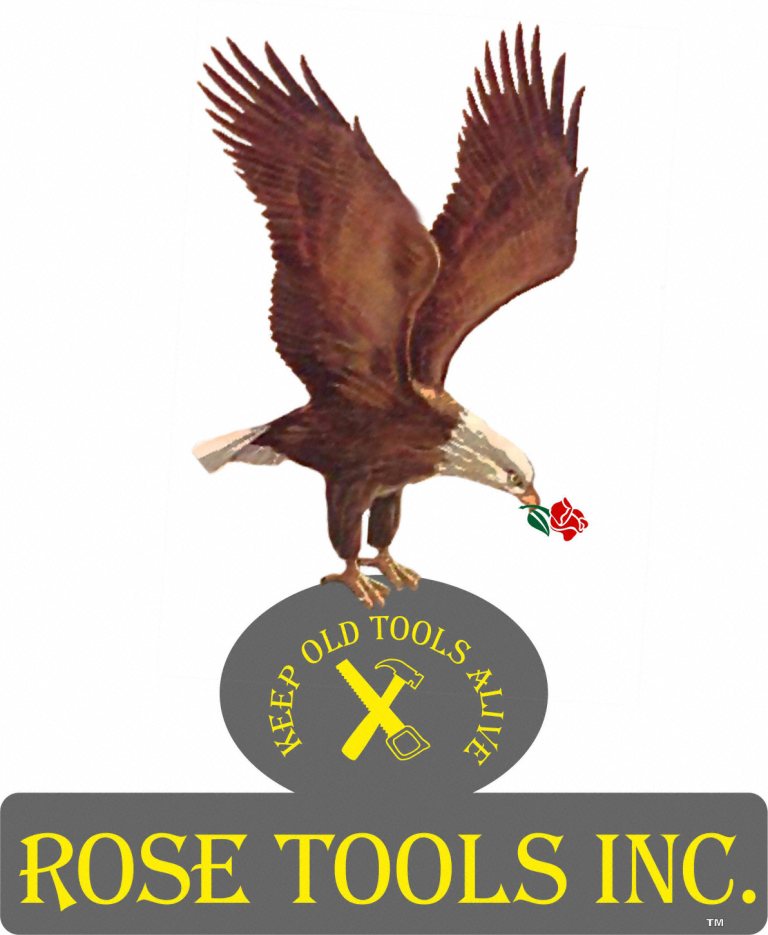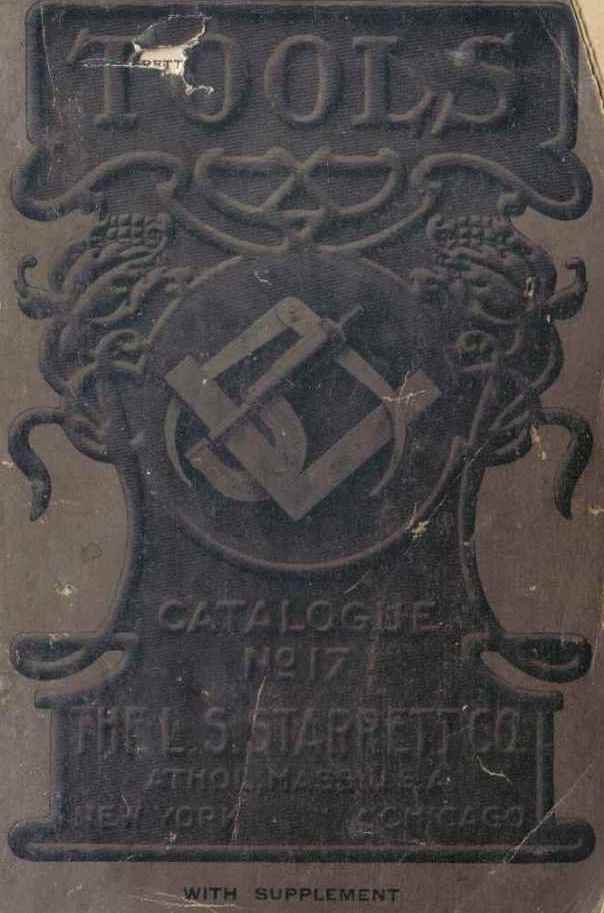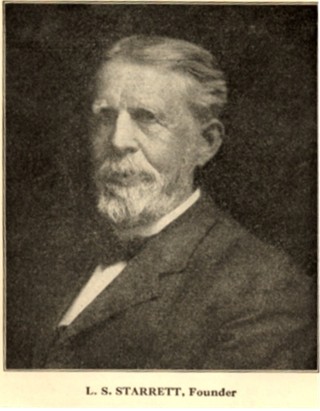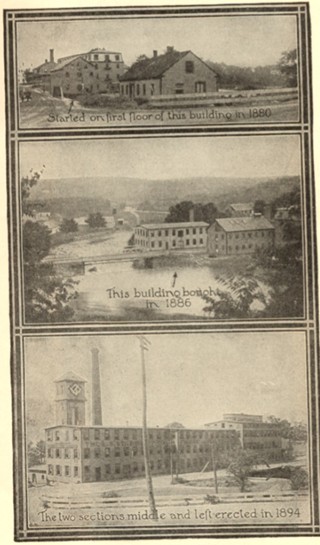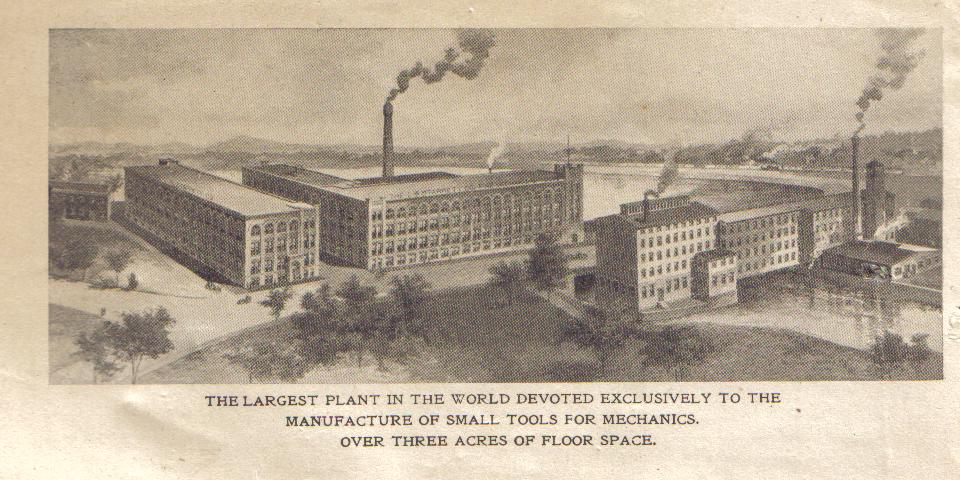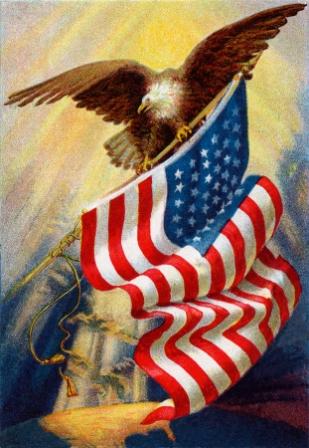|
|
HomeAmerican Axe & ToolBelknap HardwareBridgeport HardwareBrown & SharpeDisston SawsGene's Tool MuseumGoodell PrattHibbard, Spencer, Bartlett & Co.Keen KutterKeen Kutter Part TwoLufkinMillers FallsPeck, Stow & WilcoxSargent & CompanySears CraftsmanStanleyStarrettThe James Swan CompanyThe l.& I. J. White CompanyMiscellaneous Tool Catalog DownloadsBella Vista Woodcarving ClubLinksTools For Sale & Contact InformationWhat is my antique tool worth?Business assignment writing
|
We have several links to assorted antique tool catalogs which you can download for free, all
are in adobe pdf form so you will need the latest version of the adobe reader which you can download free at www.adobe.com
This website does cost money to run, the information here is free for all but if you could
make a small donation it would help us out a lot to maintain the costs and to keep this site running!
click here to download file 1895 Starrett catalog 4.53mb Click on any picture to view a larger image
Starrett 1880-Present How the Business Began Like all businesses, however large
or complex, this one started with a man and an idea. The man was Laroy S. Starrett; His idea was "to invent
something useful that people would want." Countless others have had a similar idea; the difference here was in the quality
of the man. L. S. Starrett's outstanding characteristic was confidence in himself; he was a man who in spite of one setback
after another refused to admit defeat. He had unusual ability, vision and enterprise, but without his
high courage this story of the foundation and growth of "the world's greatest toolmakers" could never have been written. L.S. Starrett, like so many of the early captains of industry,
had his roots in the soil. His boyhood in loom and picking up the shuttle which occasionally dropped
from the hand of his mother as she was weaving cloth for their garments. As he grew older he took his place with the men in
the fields and at fourteen he was trusted to drive loads of cordwood drawn by oxen to Even as a small boy L.S. Starrett was fascinated by tools.
Better than anything else he liked to be making something useful in what spare time he had. His father helped him get a saw,
plane and a few chisels; when he went to a nearby auction and bid on a draw shave and augur bit set he was the proudest boy in the
countryside. This was the first money he ever had to spend and in later years he often said it was the best trade he ever
made. The Starrett’s were a large family; with twelve children to bring up it was a struggle to make both ends meet.
Overhearing that his father had gotten in debt and the farm would have to be mortgaged as security; Laroy left the homestead and hired out at the age of seventeen. For several years he turned in his earnings until the mortgage
was paid off. He used to say that this gave him greater pleasure than putting the money in a bank and taught him the economy
he believed was essential to success. His first job was on a milk farm.
Greater responsibilities and more money followed and by the time he was twenty-six he was able to rent a 600 acre farm in yields. His ideas of planting and cultivating often went
against all precedent but they brought him top prices and blue ribbons at the agricultural shows. He bought the first mowing
machine used in that part of the country and soon paid for it by mowing for his conservative neighbors after his own hay was in. Whether running a farm, inventing a tool or organizing
a business, L.S. Starrett always looked for the better way. Skeptical neighbors were finally convinced that young Starrett
knew what he was doing and before long would have a farm of his own. But he himself had different ideas. He had what he called
invention on the brain and it was to be sidetracked. In winter and on stormy days much of his time had been spent in a room
over the stable which he had fitted up as a workshop. Here he developed his first invention, a meat chopping machine. While
he was without experience in manufacturing he had great faith in this chopper and his ability to succeed with it. When the
working model was finally perfected he sold out his farming interests and turned to business. Getting the chopper on
the market was a struggle that made farming look easy in retrospect. Everything was new; he had to learn as he went along. Always ready to listen and profit
by the experience of others, L.S. Starrett proved an apt pupil. By watching his patternmaker he discovered what was needed in a pattern to make a good
casting. When as frequently happened his machinist tried to impress him with his knowledge, Mr. Starrett quietly absorbed
it all. He hired a room that would suit his purpose, fitted it up with shafting, machinery and fixtures and began turning out his choppers.
He was badly handicapped from the start. The overhead was high for the small output. Finances were limited. He had to dig
up the orders himself and when he was out on the road selling, the manufacturing end of the business suffered. But he kept
going. He brought in a silent partner who put in some money. By selling sales rights in different countries he was able to
devote more of his time to manufacturing. The business grew and eventually he began looking around for a new location; a place where he could get water power and more capital. On this errand he met a business man from Among the patents taken out by Mr. Starrett eventually
about one hundred was a line of bench vises which are still manufactured by Starrett and a shoe hook fastener which later
was universally used. This alone was capable of bringing its inventor an independent fortune had he himself developed it.
Instead Mr. Starrett regarded the hook fastener as an item of secondary importance in the light of his keen interest in the development of precision tools
and kindred items, and sold it for a few hundred dollars. The next few years were critical. Laroy Starrett was working
harder than ever. His new products were going ahead satisfactory. Nevertheless as he approached forty he felt he was not making
the progress he should. I was unable to make much of a success in a business way until I left the Athol Machine Company and
started in for myself, wrote Mr. Starrett in Essentials to Success. But the circumstances that brought this about were not of his own
choosing! The First Starrett Tool Misfortunes that would have halted a less courageous man
befell Mr. Starrett. His wife died, leaving him with four small children to care for. He lost his hearing. His association with the
Athol Machine Company had not been happy and trough jealous rivalry he lost his position. To make matters worse, all the money
he had was tied up in the stock of this concern which, in the meantime, continued to capitalize on his inventions. Even so,
the confidence in his fellow man and the faith in God which
sustained him throughout his long life and to which he attributed his success, remained unshaken. But let him tell how he
overcame all obstacles in his own simple words: "I saw no other way but to try to create a business for myself by inventing something useful that people would
want. I had worked at pattern making and used clumsy, fixed blade try squares. I realized the need of a handier instrument, gave the subject careful study and drew a design
that pleased me, and made patterns of it, sitting at the kitchen table night after night until the small hours. I secured
a foot lathe for my room and after I had made patterns, got castings and a blade for my combination square and took them to
a nearby machine shop, engaged the best workman and stood by for two days until he got finished. The man was an expert toolmaker so when it was finished I asked; Well,
what do you think of it? He said; I would not give a damn for it. But that did not discourage me. I knew his reason. He believed
that the sliding blade in a square stock could not be ground sufficiently accurate to be depended upon, the difficulty being the then almost impossible task of grinding a perfect straight edge to form the blade, due to
the heat generated in grinding. I believed the difficulty could be overcome, and it was, so that we were finally able to guarantee
our squares standard for accuracy and they are so accepted the world over." Where the First "Starrett’s" Were Made Once Mr. Starrett had solved the problem of grinding a
perfect straight edge he set about getting his invention on the market. His first move was to find a concern that could produce
the squares in quantity. He was successful in this and after making up samples placed a contract for five thousand squares. He
financed this by borrowing from a bank in orders he found the hardware trade reluctant to invest
in any stock! They told me that while the square was a good thing there was no call for it as it had not been introduced;
that if I would work up a demand for it they would put in a stock. I took the hint
and hired several men to take orders allowing them a liberal commission on all they could sell. This scheme proved a success
and they sold like hotcakes. In fact, so successful was the introduction that the trade called for the squares before I was able to supply
them and some were quite impatient because they had to wait. By this time the business in fixed blade squares and a situation developed
that led Mr. Starrett to make other arrangements. Going back to the nearby machine shop that had made his first model, he
contracted with the proprietors to make the squares at an agreed price while he continued to buy the blades from the original
source, regrinding the edges. All went well for a while, so well that Mr. Starrett’s
former associates in the Athol Machine Company cast envious looks at his prospering new venture. They offered him full control
if he would come back. When this failed they brought suit against him and threatened ruin to all who had anything to do with
making or selling the combination square. This frightened the proprietors of the shop where the new tool was being produced.
They stopped work in spite of all I could
say or do to assure them that the Athol Machine Company was wrong and infringing my patents and that I was able to protect
them and myself and would. But they lacked faith and courage to go ahead. They said they were not going to run the risk of losing everything they had. I asked, are you willing to sell out? Yes, well be glad to sell they said. I bought him
out, hired their help and kept right on doing business in the old shop more profitably than ever. Meanwhile I brought a countersuit
against the managers of the Athol Machine Company and after a fight got an injunction obliging them to pay costs and damages. By 1881 Mr. Starrett had to have larger quarters and moved to
a frame building across the In the years that followed, facilities and personnel were doubled
several times, new brick buildings were erected on both sides of the river and the L.S. Starrett Company began to take shape
as one of Athol’s leading industries. The First Starrett Catalog Mr. Starrett’s new square was described in a simple,
illustrated leaflet. The immediate popularity of the new tool proved Mr. Starrett right when he predicted it would knock out
the old time square. But he did not stop there. Typical of his zeal for improvement even of his own inventions was his still
further expansion of the utility of this remarkable tool: Next I conceived and made the center head (for finding the center
of a circle) to slip off and on the blade in place of the regular miter head with level and scriber. Then I made a bevel protractor to go off and on the same blade,
all of which proved to be exactly what mechanics were in need of. Starrett Steel Rules and Tapes Difficulties in obtaining
square blades that were ground and graduated with sufficient accuracy forced
Mr. Starrett to build machines of his own design to do the work and the soon found himself the master of this art. He explains
how this led him into the making of steel rules: "Not only did we make a superior square blade but took up the making of a
full line of spring tempered rules. Among these was a very thin watch spring tempered rule which I termed flexible to distinguish it from those made of heavier stock.
When I put my line on the market they proved so superior to the thick, heavy soft rules being made by others that it was easy
to get the trade. This led in to the manufacture of steel tapes upon which many improvements were made in marking for easy
reading, and convenience. When Mr. Starrett saw an engineer using a steel tape, he liked to ask to see it. If he saw it was
one of his tapes, Mr. Starrett would say, That’s all right, if you use tapes with Starrett’s
name on them you will make no mistake. Starrett tapes have been even more improved since those days by special finishes, special
graduations, cases and reels for specific uses. But there is no improving on Mr. Starrett’s advice, given with a chuckle
but sincerely meant, If you use Starrett’s tapes you will make no mistake! In 1986, the Evans Rule Company joined the Starrett Company adding an extensive product offering of
short line tapes to the Starrett line of measuring tools. Fay Calipers and Dividers Came Next It was characteristic of Mr. Starrett that he was as quick
to recognize the worth of a tool made by another as one invented by himself. The Starrett catalog today lists many tools which
originally were taken over by Starrett, improved and developed to meet new uses. A typical example is in the caliper and divider
group which now numbers scores of different types and sizes. Mr. Starrett tells how it began: In 1887,
having bought the stock, machinery and patents belonging to Mr. Charles P. Fay, I added a very important branch to my business,
via, a line of spring bowed calipers and dividers with a detachable fulcrum stud. Mr. Fay had been industriously at work for
about three years in Springfield, Massachusetts, developing his patents. These proved to be superior to anything in this line
and quickly drove out all the imported makes which up to then had controlled the home market. Consequently I soon had a clear
field with a reputation and business in this line to be proud
of Mr. Fay came with the business and was with me for several years. He was one of the expert and ingenious mechanics I have
ever employed. The Starrett Micrometer Mr. Starrett’s inventive genius next turned to the
micrometer, a tool originated and manufactured in covered the adjustment too slow. There was no locking device
for screw or spindle which was needed to cause a close fit or to lock it firmly to preserve its setting. I decided to improve
it and put on the market a micrometer of my own make. I reduced the stock around the anvil, making a neater appearance. I
attached a small, knurled thumb piece speeder to the screw to rotate between the thumb and finger to speed it up and cause
the more sensitive adjustment; I adopted a covered screw; I put a split bushing in the hub around the spindle and a hollow,
knurled adjusting nut to telescope it to either cause a close fit around the spindle or lock it firmly to preserve its setting.
Still I was never satisfied with the slow adjustment of the micrometer screw, which requires forty revolutions to open or
close one inch. I therefore gave serious study to devising a micrometer that
would be absolutely accurate and capable of being adjusted instantly to its work with the range of its screw. It gave me much
pleasure to accomplish this to my entire satisfaction. The principle of this quick adjustment consists of a thimble, connected
with a spring plunger which slips over the end of a long, split nut, which automatically closes as quickly as pressure on the plunger is removed. The threaded
screw is buttress shaped with straight lip to resist back thrust, insuring accuracy. From these early micrometers the Starrett
line has grown to hundreds of different styles and sizes. Starrett micrometers are available in English measurement and metric.
The Starrett line now includes regular micrometers and both mechanical and electronic digital
readout micrometers. Further Expansion From 1883 on, the line of tools steadily broadened. Calipers,
squares and similar tools logically followed the mastery which the company had attained on the graduating of scales. The process
of engraving and etching the graduations on hardened steel were developed by Mr. Starrett. Buildings and machinery were
constantly added, in 1894 a large addition to the factory was made and in 1904 a large power house was erected. It was a year
of free soup kitchens for the unemployed, so great was the general decline in business. But Mr. Starrett believed in looking
ahead. He foresaw an inevitable boom in business following the slump. In his own words he jumped
in all the harder. Consequently, he was prepared when the tide turned. Mr. Starrett at this time bought out a small plant
in claimed his entire attention, however, so that he assisted
others in taking this cutter business which later developed into the Union Twist Drill Company of Athol. A cotton mill adjoining
the Starrett factory burned down, its site was acquired and in 1902 a new building of more than twice the floor space of the old plant was erected. Starrett Initiates Development
of Hacksaws that Cut Quicker Last Longer Quite early in the days of adding to his tool lines and facilities, Mr. Starrett realized that the hacksaw
as a cutting tool was as important to efficient shop practice as any other tool. He studied what the market offered, and then
characteristically set out on his own course. Here is how he describes it: We began to experiment in the manufacture of hacksaw blades adopting the process used by other manufacturers.
This produced a blade of fair quality but no satisfactory to us. After giving the matter serious thought we abandoned the
old process. We built a special fireproof addition connected with our plant, equipped it with tempering and hardening devices
of our own devising, built special automatic cutting up and teeth setting machines and applied exhaustive tests to learn the best
quality of steel needed for hacksaw blades. We got I and the quality of our saws has become so well known by all who use them
that we are over taxed to keep up with orders. A hacksaw blade may look simple to the uninitiated, actually few tools call
for as much manufacturing know how. The stock goes through a dozen critical processes calling or the best
of equipment, highly skilled operators and many tests for each individual blade tooth set, cutting edges, hardness and uniformity.
Starrett leadership in this field, built on its original process and equipment, has been maintained by rigid control of quality at every
production step. In quick succession after World War II there was the depression of 1949, immediately followed by the Korean
War, then a period of relative stability, followed by the Vietnam Conflict, followed by and leading into the prosperous years
of the 1980s and culminating with the 1991 Desert Storm endeavor. Starrett expanded starting with a modern post World War
II building devoted to the manufacture of saw and band saw blades. This building has been expanded five times through 1987
because of increasing sales of hacksaws and band saws and also the introduction of many new saw products such as hole saws,
jig and reciprocating saws. Finally, in order to get much needed room for
|
| Starrett Official Website |
 |
